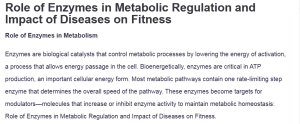Role of Enzymes in Metabolic Regulation and Impact of Diseases on Fitness
Role of Enzymes in Metabolism
Enzymes are biological catalysts that control metabolic processes by lowering the energy of activation, a process that allows energy passage in the cell. Bioenergetically, enzymes are critical in ATP production, an important cellular energy form. Most metabolic pathways contain one rate-limiting step enzyme that determines the overall speed of the pathway. These enzymes become targets for modulators—molecules that increase or inhibit enzyme activity to maintain metabolic homeostasis: Role of Enzymes in Metabolic Regulation and Impact of Diseases on Fitness.
Factors Affecting Enzyme Activity
There are several factors affecting enzyme activity. Temperature is one such factor, with moderate increases during exercise enhancing enzyme performance. However, excessive heat can denature enzymes, impairing their function. Similarly, enzymes have optimal pH levels, and deviations reduce their efficiency (Lewis & Stone, 2023).
Substrate concentration also influences enzyme activity. Notably, an increase in substrates enhances activity until saturation occurs. Additionally, chronic stress and hormonal imbalances, such as high levels of cortisol, suppress enzyme activity, which reduces metabolic effectiveness and recovery after exercise.
Disease and Exercise Performance
Myocardial infarction (heart attack), characterized by high blood levels of creatine kinase (CK-MB), is a notable example of a disease linked to elevated enzyme levels (Mechanic et al., 2023). This is a serious impairment of cardiac muscles linked with oxygen delivery and thus with ATP synthesis necessary in performance. Poor endurance and cardiovascular efficiency mean that individuals with myocardial infarction poorly support physical exercises.
Post-exercise oxygen consumption (EPOC) and lactate threshold further represent the influence of metabolic responses on fitness. EPOC is the oxygen uptake that continues after exercise to return conditions to homeostasis, while lactate threshold is the intensity of exercise at which lactate accumulation occurs exponentially. Both phenomena are related to enzyme-mediated metabolic pathways and illustrate the body’s capacity for adaptation to training and efficient recovery.
A proper understanding of enzymatic activity and its role in metabolism provides enormous insight into the physiological limitations imposed by diseases like myocardial infarction, thus pointing to the importance of tailored fitness programs for the affected.
References
Lewis, T., & Stone, W. L. (2023, April 24). Biochemistry, proteins enzymes. National Library of Medicine; StatPearls Publishing. https://www.ncbi.nlm.nih.gov/books/NBK554481/
Mechanic, O. J., Grossman, S. A., & Gavin, M. (2023, September 3). Acute myocardial infarction. National Library of Medicine; StatPearls Publishing. https://www.ncbi.nlm.nih.gov/books/NBK459269/
ORDER A PLAGIARISM-FREE PAPER HERE
We’ll write everything from scratch
Question
02 Assignment:
- Briefly describe the role of enzymes in the regulation of metabolism and factors that alter enzyme activity. Research one disease (Table 3.1, page 47) that is associated with high blood levels of enzyme and explain how this disease impacts an individual’s exercise performance and/or overall fitness.
Reading Assignment:
- Powers, S. (2023). Exercise Physiology: Theory and Application to Fitness and Performance (12th ed.). McGraw-Hill Higher Education (US). https://online.vitalsource.
com/books/9781266201882 -
- Chapters 3-5
- 11th ed
- (Table 3.1, page 159)
Role of Enzymes in Metabolic Regulation and Impact of Diseases on Fitness
- (Table 3.1, page 159)
-
02 Weblinks
Bioenergetics, Exercise Metabolism, Cells, and Hormones
Below are links to resources that will complement the material covered this week.
- Training Peaks – A site dedicated to resources for those training for endurance events. It is endorsed by multiple organizations including Runner’s World, USA Cycling, British Triathlon, and the Cannondale/Drapac Professional Cycling Team. Articles are research-based and written by specialists in exercise physiology.
- “What is Lactate and Lactate Threshold”
- https://www.trainingpeaks.com/
blog/what-is-lactate-and- lactate-threshold/ Links to an external site.
- https://www.trainingpeaks.com/
- “What is Lactate and Lactate Threshold”
- Dangers of Stress- Research-based articles highlighting the dangers of chronic stress on the body’s hormonal systems.
- “Chronic stress puts your health at risk,” The Mayo Clinic
- https://www.mayoclinic.org/
healthy-lifestyle/stress- management/in-depth/stress/ art-20046037 Links to an external site.
- https://www.mayoclinic.org/
- “Chronic stress puts your health at risk,” The Mayo Clinic
- “Cortisol: Why the ‘stress hormone’ is public enemy no. 1,” Psychology Today
- Bioenergetics – Khan Academy videos examining the basic principles of chemical processes in the human body.
- “Bioenergetics: The transformation of free energy in living systems”
- “Why do we need metabolism?”
- https://www.khanacademy.org/
test-prep/mcat/chemical- processes/bioenergetics/v/why- we-need-metabolism Links to an external site.
- https://www.khanacademy.org/
- “Insulin and glucagon”
- https://www.khanacademy.org/
test-prep/mcat/chemical- processes/bioenergetics/v/ insulin-and-glucagon Links to an external site.
- https://www.khanacademy.org/


